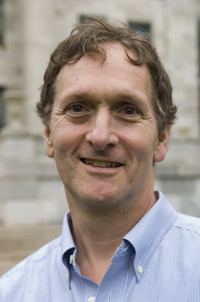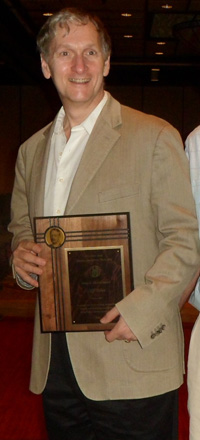|
By Marsha E. Lucas
 The
Society for Developmental Biology awarded
Clifford
J. Tabin of Harvard Medical School the 2012
Edwin G.
Conklin Medal for his extraordinary research
contributions to the field of developmental biology
and his exemplary mentoring of the next generation
of scientists. Tabin, best known for
discovering
Sonic hedgehog and demonstrating that it was the
molecule responsible for anterior-posterior
patterning in the limb bud, was nominated for the
Conklin Medal by his former students and postdocs.
In a July interview prior to the 71st SDB Annual
Meeting, Tabin expressed his appreciation. “[The
Conklin Medal] coming from peers in general and from
the society [SDB] is very meaningful. ... The fact
that ones own students and postdocs would want to do
that is heartwarming,” Tabin said. The
Society for Developmental Biology awarded
Clifford
J. Tabin of Harvard Medical School the 2012
Edwin G.
Conklin Medal for his extraordinary research
contributions to the field of developmental biology
and his exemplary mentoring of the next generation
of scientists. Tabin, best known for
discovering
Sonic hedgehog and demonstrating that it was the
molecule responsible for anterior-posterior
patterning in the limb bud, was nominated for the
Conklin Medal by his former students and postdocs.
In a July interview prior to the 71st SDB Annual
Meeting, Tabin expressed his appreciation. “[The
Conklin Medal] coming from peers in general and from
the society [SDB] is very meaningful. ... The fact
that ones own students and postdocs would want to do
that is heartwarming,” Tabin said.
“I have learned that
the reason that I got this award was that a
particular former postdoc of mine decided that she
wanted to see if other people would be interested in
nominating me and she wrote to all of my former
students and postdocs and an extraordinarily large
number of them bombarded the SDB office with
letters. And when the SDB office couldn’t find any
other nominees because the letters were buried in
the big pile of Tabin nominating letters...they
said, ‘Well, I guess this is the only guy this year’
and they gave it to me,” he recalled jokingly.
Tabin began his
scientific career as a graduate student with Robert
Weinberg at the Massachusetts Institute of
Technology in 1976. There he worked on recombinant
DNA constructing the
first retroviral vector, an
essential molecular tool for introducing new genes
into cells. He also
identified the genetic mutation
in a bladder cancer cell line which activated RAS,
the first known human oncogene. He was able to show
that the mutated RAS gene when placed in a
retroviral vector and injected into mice could cause
cancer.
In 1984, Tabin began
a short postdoc in Douglas Melton’s lab at Harvard
University. He along with fellow postdoc Richard
Harvey
cloned the first Xenopus Hox genes (at the
same time Eddy De Robertis’ lab cloned different
Xenopus Hox genes). Tabin became interested in
studying whether Hox genes were differentially
expressed in the hind limb and forelimb. “I said,
‘Why don’t we see if we can bring modern molecular
biology to limbs and use Hox genes as a starting
point?’”
Since Melton’s lab
focused on early Xenopus development and early
tadpoles don’t have limbs, Tabin sought out an
independent postdoc at Massachusetts General
Hospital (MGH). “The independent postdoc is a
gamble,” he said. “When people talk to me about it I
tell them don’t do it unless you’re a hundred
percent comfortable with the idea that if you do it
and it falls flat, you’ll do a second postdoc.”
Tabin was in no rush to move on to the next stage of
his career and his gamble paid off. At MGH he
switched amphibian species and studied limb
regeneration in newts. Taking a molecular approach,
Tabin cloned
Hox genes differentially expressed in
regenerating limbs and a
retinoic acid receptor that
functioned in regeneration.
This independent
postdoc gave Tabin a head start as he transitioned
into a faculty position at Harvard University in
1989. He developed
tools for ectopically expressing
genes in the chicken embryo, expanding the
possibilities for studies in yet another classical
limb system. Through a collaboration with
Andy
McMahon and
Phil Ingham, he discovered Sonic hedgehog was the
molecule acting in the vertebrate
limb bud to control anterior-posterior patterning.
This was the first example of a morphogen that acted
in a concentration dependent manner to establish
distinct developmental fates. He went on to study
left-right asymmetry linking the signaling molecules
Sonic hedgehog and Nodal in a genetic cascade.
Tabin’s lab has
tackled limb development with diverse organisms
including chickens, mice, jerboas, and axolotls. He
has studied development of the gut, muscles, bones,
and tendons to name a few. He helped establish the
field of evolutionary developmental biology with his
studies on beak development in
Darwin’s finches and
the evolution of
cave fish.
“I’ve always just
sort of studied whatever questions I find
interesting,” he said. “You can’t start out your
career being all over the map or you’d never be able
to get your feet off the ground.” However, now he
has the luxury to study many questions around a
common theme—how morphology arises.
“Fundamentally, the
difference between a cat and a mouse is not
different cell types. The differences between a cat
and a mouse are very subtle differences in how you
form morphological structures. ... The subtle
differences in morphology make all the difference in
giving us the beauty and variety around us,” he
said.
In addition to
scientific excellence, the Conklin Medal awards
great mentors. “I take the mentoring role or the
role of launching other people’s careers very
seriously,” Tabin said.
This is evidenced by
the amount of time he puts into helping his trainees
learn to write papers, prepare talks, and if they’re
interested, finding opportunities for them to teach.
This is important, he said, for their success down
the road.
|
 |
|
Tabin after receiving the Conklin Medal
at the 71st SDB Annual Meeting in
Montreal, Canada. |
With Tabin’s broad
interests, he allows his students and postdocs to
pick their own projects. “My basic philosophy is you
get the best people you can, you try and raise
significant resources so they have a lot of
flexibility financially to do whatever they want,
and then you just support them in whatever they want
to do. ... And if you give really good people a
great environment and a lot of resources, they’re
going to do great stuff. And if you’re doing it with
them, it’s going to be a lot of fun.”
As for his own
mentors, he said, “I should start with my parents
here because fundamentally what you’re like
personally has an enormous amount to do with the way
you’re going to run a lab. ... It was my parents who
taught me to be a man.”
His father was a
physicist and had a similar career in research,
while his mother (now deceased) was a psychologist.
Being able to share his successes with them
throughout the years has been one of the most
rewarding parts of his career.
“The meaning of
these [awards] are not lost on my father,” he said.
Even though there is no actual medal that comes with
the Conklin Medal, Tabin said, “Whatever they give
me, my dad’s going to ultimately get [it].”
|